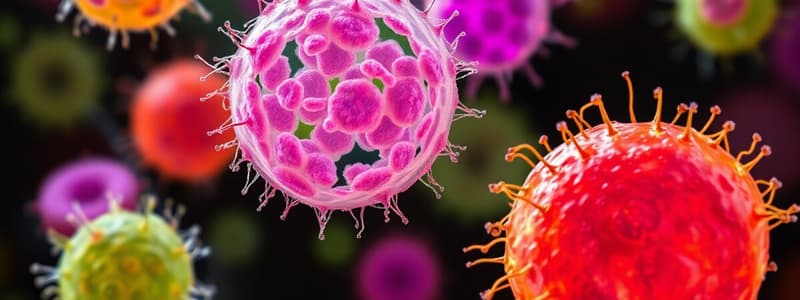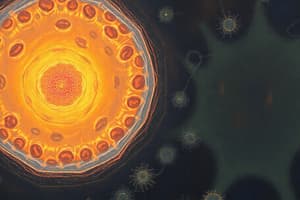Podcast
Questions and Answers
What is a distinguishing feature of prokaryotic cells compared to eukaryotic cells?
What is a distinguishing feature of prokaryotic cells compared to eukaryotic cells?
- They have multiple linear chromosomes.
- They reproduce through mitosis.
- They lack a membrane-bound nucleus. (correct)
- They can form multicellular organisms.
Which size range generally describes eukaryotic cells?
Which size range generally describes eukaryotic cells?
- 0.5 to 5 micrometers
- 10 to 100 micrometers (correct)
- 50 to 200 micrometers
- 1 to 10 micrometers
What type of reproduction do prokaryotic cells primarily undergo?
What type of reproduction do prokaryotic cells primarily undergo?
- Spore formation
- Binary fission or budding (correct)
- Mitosis and meiosis
- Fragmentation
What is a key difference in the genetic material of prokaryotic cells compared to eukaryotic cells?
What is a key difference in the genetic material of prokaryotic cells compared to eukaryotic cells?
Which of the following is a feature common to both prokaryotic and eukaryotic cells?
Which of the following is a feature common to both prokaryotic and eukaryotic cells?
What is the composition of the cell wall in prokaryotic cells?
What is the composition of the cell wall in prokaryotic cells?
How do eukaryotic cells primarily reproduce somatic cells?
How do eukaryotic cells primarily reproduce somatic cells?
Which structure is typically absent in prokaryotic cells compared to eukaryotic cells?
Which structure is typically absent in prokaryotic cells compared to eukaryotic cells?
Flashcards are hidden until you start studying
Study Notes
Overview of Cells
- Cells are the fundamental building blocks of life, essential for independent existence and reproduction.
- Two primary types of cells exist: prokaryotic and eukaryotic, differentiated by the presence of a nucleus.
Prokaryotic Cells
- Unicellular organisms classified under the kingdom Monera, encompassing domains Archaea and Bacteria.
- Size typically ranges from 1 to 10 micrometers, making them significantly smaller than eukaryotic cells.
- Lack a membrane-bound nucleus; genetic material is localized in the nucleoid region.
- DNA is usually a single circular chromosome, facilitating genetic engineering.
- May possess protective features like a capsule or slime layer for defense and adherence.
- Reproduce asexually, primarily through binary fission or budding, allowing for rapid production of identical cells.
Eukaryotic Cells
- More complex and larger cells, ranging from 10 to 100 micrometers, capable of forming multicellular organisms.
- Contain a membrane-bound nucleus housing genetic material organized into multiple linear chromosomes.
- House numerous organelles, including mitochondria, endoplasmic reticulum, and Golgi apparatus, each serving specific cellular functions.
- Reproduce through both mitosis for somatic cells and meiosis for gametic cells (sperm and egg).
Key Differences Between Prokaryotic and Eukaryotic Cells
- Nucleus: Eukaryotic cells possess a defined nucleus, while prokaryotic cells do not.
- Cell Wall Composition:
- Prokaryotes have cell walls made of peptidoglycan.
- Eukaryotic plant cells have cellulose, fungal cells have chitin, and animal cells lack a cell wall.
- Genetic Material: Prokaryotic DNA is circular; eukaryotic DNA is linear, organized in pairs.
- Organelles: Eukaryotic cells contain a variety of membrane-bound organelles, unlike prokaryotes, which have few or none.
- Cell Division: Prokaryotes divide by binary fission; eukaryotes use mitosis and meiosis.
Common Features
- Both cell types include:
- Cytoplasm: The entire content inside the cell membrane, excluding the nucleus.
- Ribosomes: Non-membrane-bound structures responsible for protein synthesis.
- Plasma Membrane: A selectively permeable barrier separating the cell’s interior from its external environment.
- DNA: Contains the genetic instructions crucial for cellular functions.
Studying That Suits You
Use AI to generate personalized quizzes and flashcards to suit your learning preferences.




